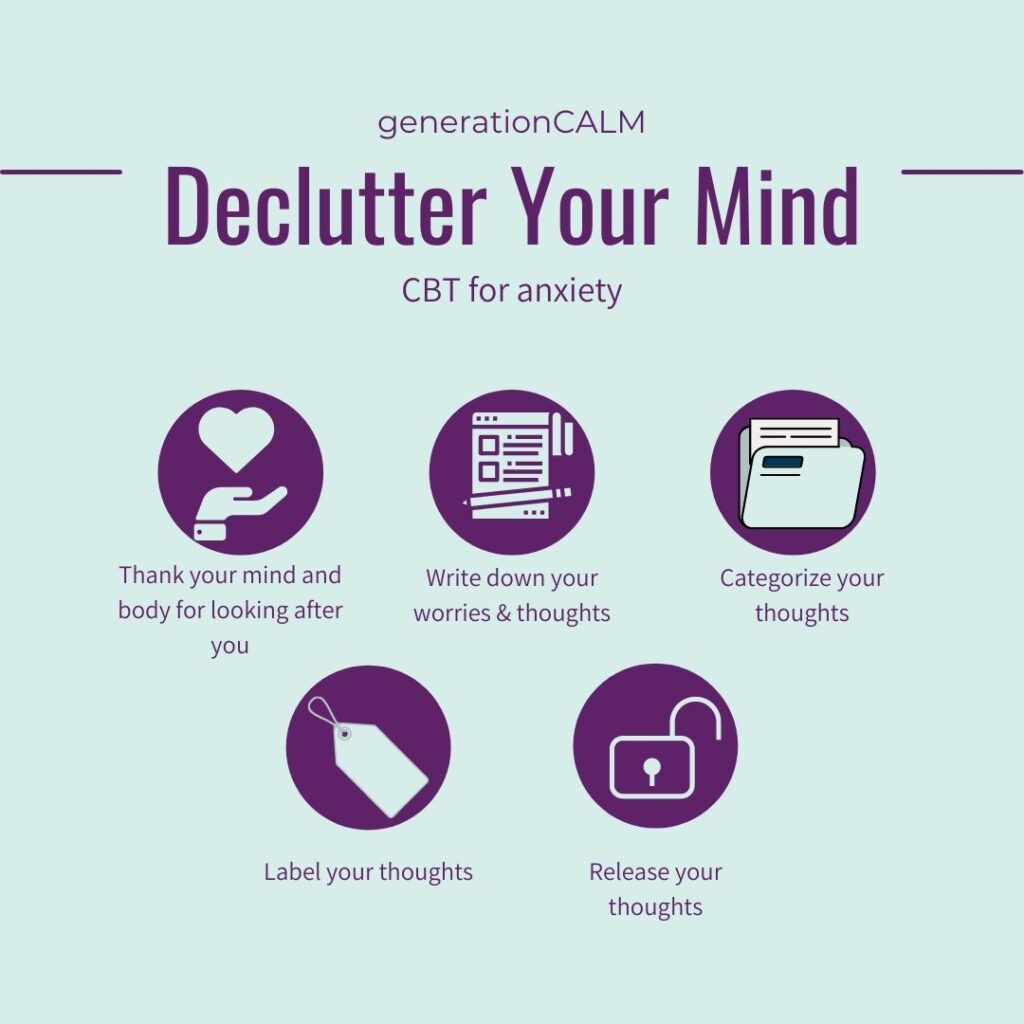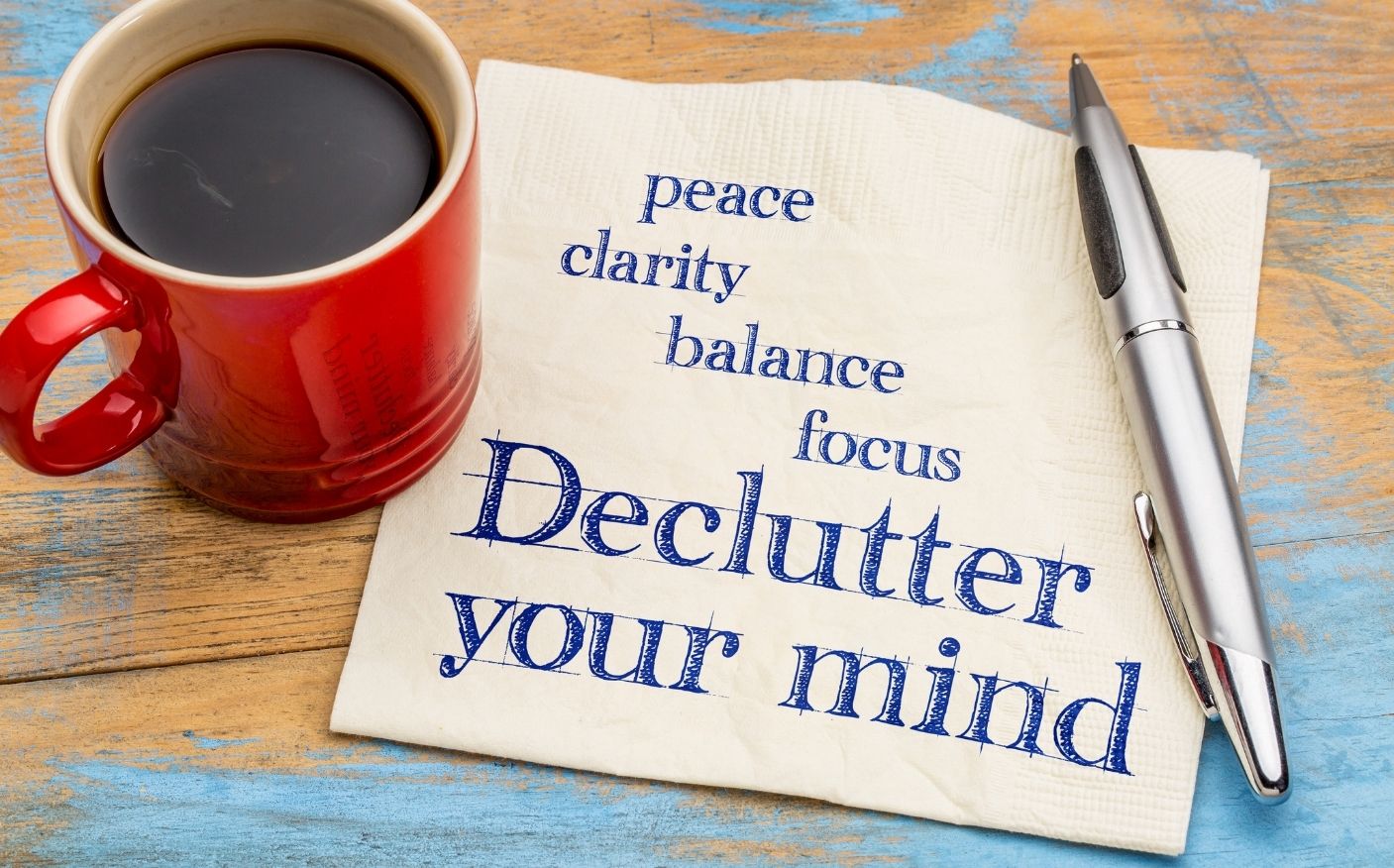How CBT Can Reduce Anxiety By Decluttering Your Mind
I’ve been watching Marie Kondo’s show ‘Tidying Up‘ on Netflix. I love the show.
The premise of each episode is that she enters a family’s house and instead of shaming them for their clutter like other similar reality shows, she thanks the house, thanks the clothes and objects before designating them to a dump pile.
She guides the family to sort through their own belongings rather than doing it for them, which I really like. As a psychologist I never tire of seeing the impact that clearing clutter has on the family.
It demonstrates that all areas of your life are interconnected in a network, and so improvement in one area will enhance another. In the Marie Kondo show, the knock-on effects for these families are rekindling time and love for each other.
So I got to thinking…what would happen if Marie Kondo got into my brain and cleared out my thoughts.
Keep reading, because I’m going to show you how to spring clean your thoughts.
Cognitive Behavioral Therapy (CBT)
Part of what I did as a Clinical Psychologist was use the principles of CBT to help people understand and ‘challenge’ negative thoughts.
Over the years I have wondered if the approach isn’t a little too contrived. Many others thought the same thing and so more mindfulness therapies abounded such as DBT and ACT. Where you merely notice your thoughts and accept them rather than try to change them.
But what if you could Marie Kondo your thoughts?
So I examined the show (ie., binge-watched the entire series) and came up with a protocol to ‘spring-clean your mind’.
LESSON 1: Thank your mind and body for looking after you.
When you realize for the first time that your thoughts and beliefs might be affecting your behaviors, there can be a kind of shame associated with that. “How can I not have noticed I’m my own worst enemy?” you might scream.
Self-compassion is the best way to deal with yourself while mining for negative thoughts and beliefs.
You have built an entire system of beliefs based on your experiences, cultural, upbringing and knowledge, up until this point. Your mind and body have done the best they can to protect you – and a bloody good job at that – so there’s no point getting annoyed at yourself. Instead, thank your body and mind for protecting you, but that you got it from here.
Marie Kondo has a short ritual at the beginning of each show, after being introduced to the family.
She gets on her knees and thanks the house. It’s always a touching moment, because no-one in the house has thought of the house as an entity before. They’ve taken it for granted.
It’s the same with your mind. Take a moment to acknowledge its purpose and help in your life. Thank your mind.
How to do a gratitude for your mind ritual. (Day 1: Time needed:2 minutes)
Be still. Sit down with your hands pressed together against your heart … and in your mind (or out loud) say thank you to your wonderful mind for its protection, love and selfless devotion. Let it know you appreciate and respect the work it does tirelessly for you. Let your mind know that you will no longer take it for granted but will help out as much as possible.
If you want to learn how to start a gratitude journal, I have written a step-by-step approach.
LESSON 2: Get all your clutter out.
Write down your thoughts. In one, large pile!
Your brain can get cluttered with so much information. If you are like me, you clutter it with many internet articles, shows, podcasts, world news ….it becomes a dumping ground. Not organized in a system like a library.
When you finally get downtime and find some silence …you find it’s not silent at all. Our brain projects us into the future or the past and starts digging for information to worry about. Our instinct may be to ignore all those thoughts because they cause us pain. But we need to get them all out and examine them one by one. Give them the attention they deserve.
They are automatic and won’t go away unless you acknowledge them.
This step corresponds to Marie Kondo having all the family members pull their clothes into one big pile.
How to get your thoughts out. (Day 2: 5 minutes daily)
Sit down with a journal and write down the thoughts you’ve had today. There are no bad or good thoughts. Just thoughts. No need to label them. Just look at them. You are not going to be able to get them all out at once. But you’ll get into the practice of noticing and acknowledging them throughout the day.
If you can, start each sentence with “I’m having the thought that……’
This helps you to see your thoughts as just that…a thought.
LESSON 3: Get more specific about your thoughts and worries
Marie Kondo has the members of the household sort through categories. Clothes first, books, papers, everything miscellaneous…ending with sentimental items.
We all have different aspects of our lives we have thoughts and beliefs about. Relationships, work, food, specific fears, money, exercise, health, spiritual.
This stage is about increasing your awareness of what exactly you worry about.
Make a list of all the areas in your life that you have thoughts and worries about. This will look different for everyone.
For example,
Helping my aging parents
Being a good mother
Not exercising enough
Making healthy meals for the family
Not having a good nest egg for retirement
Managing schoolwork
Political issues
How to arrange your thoughts into categories (Day 3: 30 minutes)
So, in Marie Kondo style, start to arrange your daily thoughts in categories. Use different colored highlighters to group similar worries together from your thought-catching chart.
Take time to reflect on each area of your life. Both where you have been in the past, and now. And also what your goals are for the future. This allows you to value each area of your life.
When you have finished this process have you got a vision of what life you would like to lead? Does your life currently spark joy for you? How would you like your life to look like?
Write down these goals or create a vision board.
LESSON 4: Create a labeling system
Going forward, when you catch yourself caught up in the cycle of worrying, pay attention to the physical sensations of your emotion. (link to that diagram of where we feel emotions in our body).
First, notice the worrying thought and describe it.
“I am having the thought that…”
Second, turn your attention to your body and see if you can identify sensations. Some people might notice a quickening of the heartbeat, a tensed stomach or feeling hot.
If you have anxiety, this will be one area where you will excel. A person with anxiety is much more attuned to their bodily sensations such as blushing, trembling. Ellen Hendrickson talks about this on page 183 in How to be Yourself.
Simply pay attention to what you are feeling.
Thirdly, try to label the emotion. Is it anger, fear, irritation?
Tell yourself it’s OK to have these feelings. Notice how your emotions come and go over the space of a day. Sometimes we try to avoid these emotions and pretend they’re not happening. Especially as women who are taught that it’s not ladylike to be angry, or have our irritability dismissed as part of our menstrual cycle.
Being non-judgmental about your thoughts and emotions allows them to pass more freely.
LESSON 5: Celebrate the present moment
Just like in Tidying Up, it can be hard for people to let go of possessions. In your mind, it can be hard to let go of thoughts. They’ve had such sticking power up until now. It can be tricky to let go of worrying thoughts. Even though they may bring you worry, they have been your constant companion until now. There’s familiarity in them.
So, this final skill is about noticing the thoughts and allowing them to pass without attaching to them. Sometimes this can be difficult because we feel guilty about not worrying. For example, a mom may feel guilty for not worrying about the health of their daughter. “Maybe that means I don’t love her enough.”
But having this thought does not spark joy for you or your daughter, it does not serve a useful purpose. So, notice it as a thought, then allow it to move past.
The conveyor belt of thoughts (Daily activity for 5 minutes)
Imagine your worrisome thoughts on a conveyor belt. Allowing you to examine them briefly but then moving on out of sight. Be determined to let them pass.
Then move on to being in the moment and bringing your full attention back to whatever activity you are engaged in. If you get distracted by a worrisome thought again, gently bring yourself back to the present moment.
Practice this skill daily. By allowing your thoughts to pass by without attaching to them, you are free to engage in the present moment. Immerse yourself in your daily experiences.

CBT for Anxiety
So there you have it, 5 components to spring clean your thoughts. This is just one way CBT can reduce anxiety.
Once you have learned this skill set it will be easy to maintain. You’ll feel freer for not being on automatic pilot and a slave to your thoughts and emotions. You’ll have more respect for your thoughts – positive, negative or neutral.
It would be an unrealistic and impossible feat to stop worrying altogether. Much better to pay attention to your thoughts, notice that they are just thoughts, thank them for their work and mindfully avoid getting caught up in them. Notice the sensations those thoughts produce in your body and label your emotions.
These skills will allow you to show up fully for your life. Without the distraction of your naysaying thoughts you’ll be able to better manage the fears that limit your life.
So grab a journal and take some time to start this process.

